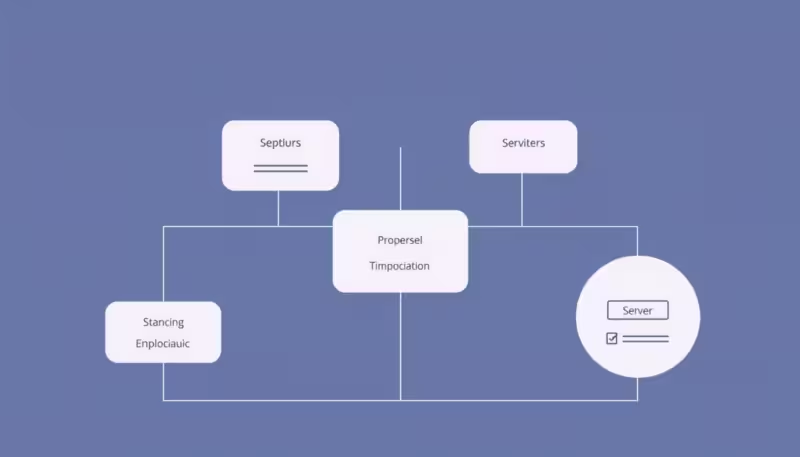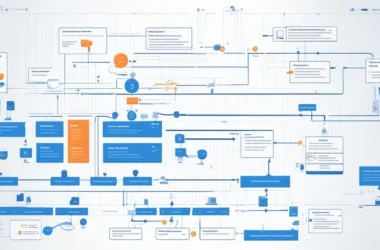The KISS Principle stands for “Keep It Simple, Stupid.” It’s key in software architecture. It pushes for simple design, making software more efficient and easy to use. With everything getting more complex, simpler designs make things easier to use and keep up.
Amazon uses the KISS principle as a main idea, helping them create new designs. Examples like Brain Box Labs and UTS Sydney show how simplicity boosts user interest. They prove that straightforward designs can greatly engage users.
The KISS principle guides software developers to aim for simplicity. This helps meet users’ various needs without complicating things. It shows that good software makes things easier for people, focusing on their experience.
Introduction to the KISS Principle
The KISS Principle is all about keeping things simple in software development. It started in the 1960s. Developers are urged to keep systems simple to use and easy to maintain. This idea is key in many engineering areas, helping projects succeed.
The Lockheed F-35 plane was built using the KISS principle. This shows how crucial it is in serious engineering tasks. Famous people like Einstein and Da Vinci praised simplicity. Einstein wanted things as simple as possible. Da Vinci saw simplicity as the height of sophistication.
The KISS principle has variants like “Keep it Short and Simple.” In software development, it makes work easier and improves teamwork. It helps reduce technical debt and boosts performance. This makes fixing bugs easier and development more efficient.
Understanding the Importance of Simplicity in Software Development
In software development, keeping things simple is key. It makes solving problems, fixing bugs, and updating systems easier. Following the KISS principle helps teams work better together and face less disagreements during code reviews. This leads to better software designs and a happier work environment.
Too much complexity can cause frustration and make developers feel burnt out. A study showed that using the KISS principle reduced code complexity by 20% and bugs by 15% after launching. Keeping business requirements simple lowers complexity. This lets teams concentrate on creating high-quality software.
Adopting simplicity helps new developers get up to speed 30% faster. It also cuts down on unnecessary code, which reduces confusion and saves time during code changes. By keeping the codebase small, it becomes easier to manage and improve the software’s quality.
Putting simplicity at the forefront of software design improves the experience for users and meets the needs of developers. In a fast-moving industry, simplicity is essential for successful projects.
The Origins of the KISS Principle
Kelly Johnson at Lockheed Skunk Works created the KISS Principle. His innovative ideas changed how products are designed. They focused on being simple and easy to fix, even in tough situations. For example, the S-71 Blackbird spy plane showed his approach well. It was tough but easy to use.
The principle is often summed up as “keep it simple, stupid.” It’s key in many areas like software development. Kelly Johnson’s thoughts started a big talk on simplicity in engineering. Simplicity became crucial for products to be liked and used by many. This idea changed how designers think about making products. They now focus on what users really need.
Variants like “keep it short and simple” show the principle’s flexibility. The main point is to make things clear and useful while keeping their important functions. This idea connects with Occam’s Razor and Albert Einstein’s views on simplicity. Thus, the KISS Principle guides engineering and software design by promoting simplicity.
KISS Principle as a Core Design Philosophy
The KISS design principle is a key idea in software design. It tells us to keep designs simple to reach more people. The term “keep it simple, stupid” comes from Kelly Johnson at Lockheed Skunk Works. He believed in making systems that work well and are easy to use.
Across many types of engineering, the KISS principle guides managers, teachers, and trainers. It could be seen as the first rule for making user-friendly products. By keeping things simple, more people can understand and use a product, which can increase its popularity. This push for simplicity helps make products that people enjoy using more.
There are different ways to say the KISS principle, like “keep it short and simple” or “keep it simple and straightforward.” These versions all focus on making things better for the user without losing important features. With the KISS principle, it’s understood that sometimes more complex things can make a product better. For example, professional cameras have more features than phone cameras and are better for certain tasks.
In summary, the KISS principle is a great guide for designing software. It encourages designers to find the right mix of simple and advanced features. This mind-set helps create products that are easier and more fun to use, leading to more people using them.
Core Concepts of the KISS Principle
KISS principles focus on simplicity and clarity in software development. They help designers and developers create user-friendly and maintainable solutions. This approach tackles functionality with ease.
Simplicity in Design
Design simplicity makes interfaces clear and easy to use. This means cutting out unnecessary features to avoid clutter. With a clean design, user satisfaction soars, and usability improves.
Key to simplicity are intuitive layouts, a gentle learning curve, and easy updates.
Clarity in Communication
Clear communication is vital for successful project management in development teams. It ensures everyone understands the design principles and choices made. This clarity reduces misunderstandings and keeps goals aligned.
It involves open team dialogues, detailed documentation of decisions, and regular stakeholder updates.
Key Principles Behind the KISS Principle
The KISS principle is all about keeping things simple and maintainable. It helps developers make designs that are easy to understand. This improves user experiences. A simpler product is more useful, as it fits better in our lives.
Simplicity Over Complexity
Being simple is key for good design and it makes users happy. If a product is easy to use, more people will want it. Phrases like “keep it short and simple” show that simple is always better.
Maintainability of Software
Software needs to be easy to update and fix. That’s what KISS suggests. Organized and modular code is easier to manage. It cuts down on technical debt and makes it easier to meet new needs.
Practical Applications of the KISS Principle in Software Engineering
The KISS Principle plays a big role in software engineering. It makes software easier to use, maintain, and develop. This part shows how KISS works in designing interfaces, organizing code, and creating algorithms.
User Interface Design
Simplicity rules in UI design. Minimal elements make apps easy to use. Users find what they need without getting lost.
Clear navigation and consistent layouts are key. They make apps more intuitive. This way, users enjoy a seamless experience.
Code Organization and Architecture
Organizing code well is vital. It makes the system easier to handle. Modular designs help keep things simple.
Each module or class should do just one thing. This makes the code straightforward. It’s better to avoid adding features you don’t really need.
Algorithm Implementation
Simple algorithms work best. They solve problems without adding confusion. Codes should be easy to read.
Use clear variable names and add helpful comments. This makes it easier for others to understand and update the code.
Variants and Related Principles to KISS
The KISS principle was created by Kelly Johnson. It stands for keeping things simple in design and choices. This principle is often rephrased as “Keep it Short and Simple” or “Keep it Simple and Straightforward.” These phrases mean the same basic thing: effectiveness comes from being easy to understand and use.
Many other principles also praise simplicity. Occam’s Razor suggests choosing the simplest option as the best solution. Albert Einstein advised making things simple, but not overly so. Leonardo da Vinci and Mies van der Rohe believed in simplicity, too. Da Vinci spoke of simplicity with sophistication, while van der Rohe said “Less is more.”
In various areas, keeping things simple is key to better experiences. Bjarne Stroustrup, creator of C++, says it’s important to make easy tasks simple. The different versions of KISS and related concepts show us that simplicity helps people get more involved. It also makes them more likely to use products and services.
A Note of Caution When Applying the KISS Principle
Applying the KISS Principle requires careful thought. It aims for simple design but should not reduce functionality. For instance, while it promotes simplicity, cutting too much can hurt usability.
This issue often shows up in product design where some complexity is good. Take DSLR cameras compared to smartphone cameras, as an example. More complex DSLR cameras often offer a better user experience than simpler smartphone cameras.
Designers should aim for a balance between simplicity and functionality. Being minimalistic shouldn’t mean sacrificing performance. The Lockheed F-35 is a great example of this balance. It shows that simplicity and clarity can exist in complex engineering projects.
The mantra “less is more” is widely respected across various domains. It encourages a less cluttered approach. But, care is needed to ensure simplicity does not ignore user needs. Effective results come from keeping designs simple without losing sight of clear communication with users.
Conclusion
The KISS Principle is key in software design, preaching simplicity over complexity. It was first introduced by Kelly Johnson. This principle is not just for tech but for creating easy-to-use, efficient solutions in many areas.
By sticking to KISS, developers can make innovations that users find easy to use and maintain. Simplicity wins.
Embracing simplicity goes beyond design; it’s a top strategy for engagement. It leads to easier use and gets good feedback in the competitive world of software. Focusing on what’s essential helps avoid user frustrations.
Putting the KISS principle to work helps make developing products smoother. Keeping things simple means teams can keep users happy and coming back. KISS shows us that smart design is about being simple and effective. That’s how to succeed in software.






